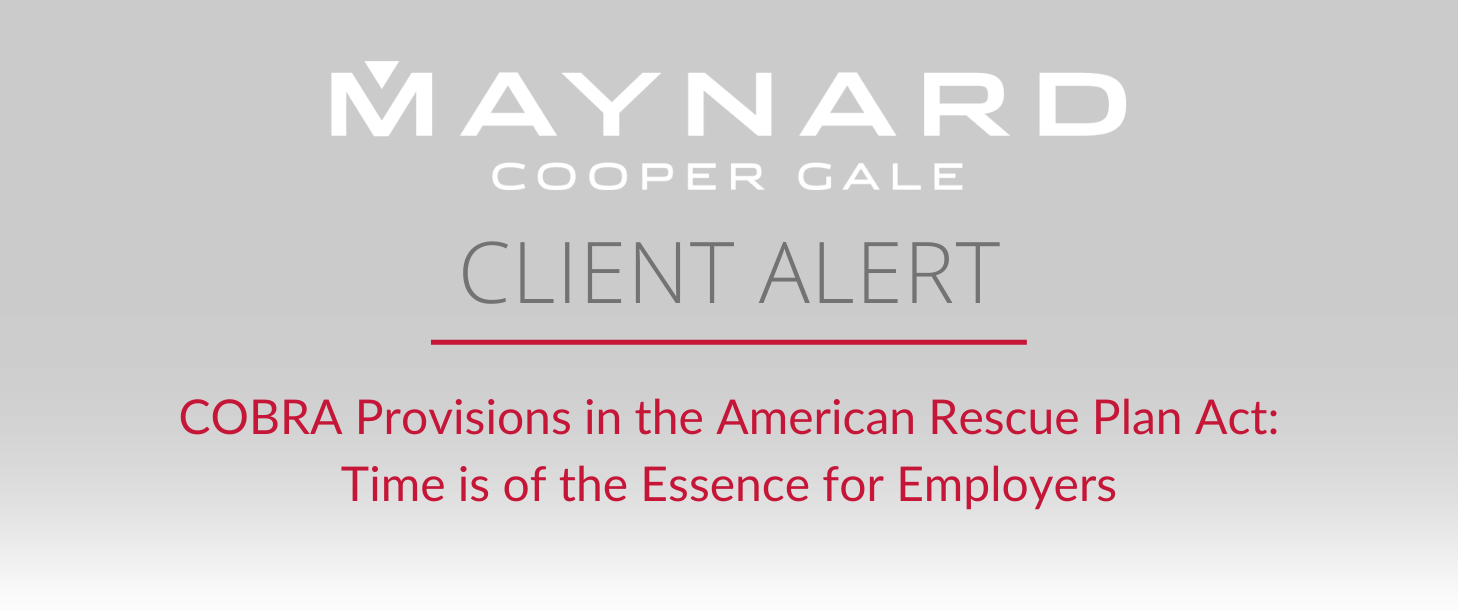COBRA Provisions in the American Rescue Plan Act: Time is of the Essence for Employers

On March 11, 2021, President Biden signed into law the American Rescue Plan Act of 2021 (“ARPA”), which is the latest round of federal economic stimulus legislation in response to the ongoing COVID-19 pandemic. The ARPA has several benefits-related provisions, the most notable of which is the COBRA premium subsidy and its related election period extension and notice requirements. As discussed in more detail below, these COBRA provisions, which apply to both fully insured and self-insured group health plans subject to COBRA, take effect as soon as April 1, 2021, which means that employers have a limited window of time to get familiar with and implement these provisions in order to avoid costly penalties for COBRA non-compliance.
COBRA Premium Subsidy
The ARPA establishes a COBRA premium subsidy, which will cover COBRA premiums at 100% for certain assistance eligible individuals (“AEIs”) during the period from April 1, 2021 through September 30, 2021 (the “Subsidy Period”). An “AEI” is a qualified beneficiary who is eligible for and elects COBRA for a period of coverage within the Subsidy Period due to a qualifying event of involuntary termination of employment or reduction of hours.
The employer (or, in some cases, the plan or insurer) will pay 100% of an AEI’s COBRA premium during the Subsidy Period and will be reimbursed by the federal government through a credit against payroll taxes or, for credit amounts exceeding payroll taxes, as a refund of an overpayment.
The Subsidy Period will last for six (6) months at most and may be shortened for AEIs who reach the end of their COBRA maximum coverage period (generally, 18 months) or who become eligible for coverage under Medicare or another group health plan (excluding coverage consisting of only excepted benefits, health FSAs, and qualified small employer HRAs (i.e., QSEHRAs)) earlier than September 30, 2021.
Extended Election Period
Individuals who do not have a COBRA election in effect on April 1, 2021, but who would be AEIs if they did, are eligible for the subsidy. In addition, individuals who elected but discontinued COBRA coverage before April 1, 2021, are eligible if they would otherwise be AEIs and are still within their COBRA maximum coverage period. These individuals may elect COBRA during the period beginning on April 1, 2021, and ending 60 days after they are provided required notification of the extended election period. Any election for these AEIs would be prospective only, and not retroactive to the date coverage was lost.
Plan Enrollment Option
The ARPA also creates a “plan enrollment option,” under which a plan may (but is not required to) permit AEIs to elect to enroll in a different coverage option (i.e., a different group health plan offered by the employer other than QSEHRAs, health FSAs, or coverage that offers only excepted benefits). An AEI has 90 days after notice of the enrollment option is provided to make the election. The different coverage option cannot have a premium that exceeds the premium for the individual’s existing coverage and must also be offered to active employees.
Notice Requirements
Group health plans must timely notify AEIs who become eligible to elect COBRA during the Subsidy Period of the subsidy’s availability. Plans must also provide notice to any individuals eligible to elect COBRA under the extended election period described above (i.e., any individuals who experienced a COBRA event due to an involuntary termination or reduction in hours and who are still within their 18-month maximum COBRA period) regarding the subsidy’s availability and the extended election period by May 31, 2021. These notice obligations can be met by amending existing notices or by providing the required notices in a separate document.
The ARPA directs the DOL to issue model notices by mid-April. A plan can also prepare its own notices. The notices must contain the following:
- The availability of the COBRA premium subsidy and the conditions for receiving it;
- The forms necessary for establishing eligibility for the COBRA premium subsidy;
- The name, address and telephone number necessary to contact the plan administrator and any other person maintaining relevant information in connection with the COBRA premium subsidy;
- A description of the extended election period; and
- A description of the option to enroll in different coverage, if adopted by the employer.
In addition to the above, plans must separately notify AEIs of their subsidy’s expiration between 45 and 15 days before the expiration date, unless the subsidy is expiring because the AEI has become eligible for coverage under another group health plan or Medicare.
Employer Takeaways
In light of the COBRA premium subsidy’s quickly approaching effective date of April 1, employers should immediately begin taking steps, either internally or through communications with their COBRA third-party administrator (“TPA”), to determine which employees and their dependents may be eligible for the COBRA premium subsidy and extended election period, so they can deliver the required notices to all AEIs by the May 30th deadline. Generally, this will include any employees and dependents who were eligible for or elected COBRA due to an involuntary termination of employment or reduction of hours within the past 18 months (on or after November 1, 2019). If an employer utilizes a COBRA TPA, it is likely that the TPA will handle implementation of these COBRA provisions for the plan, including sending the required notices; however, the employer should still confirm that the TPA is taking all necessary steps to ensure the plan is complying with the ARPA and should keep the TPA updated on any new potential AEIs throughout the Subsidy Period.
This Client Alert is for information purposes only and should not be construed as legal advice. The information in this Client Alert is not intended to create and does not create an attorney-client relationship.
About Maynard Nexsen
Maynard Nexsen is a full-service law firm with more than 550 attorneys in 24 offices from coast to coast across the United States. Maynard Nexsen formed in 2023 when two successful, client-centered firms combined to form a powerful national team. Maynard Nexsen’s list of clients spans a wide range of industry sectors and includes both public and private companies.
Related Capabilities













